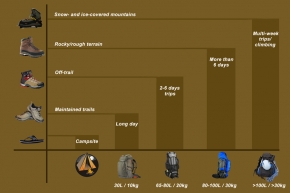Hiking Footwear
Choosing suitable footwear involves matching your needs to one of the many different styles available. Hiking footwear ranges from lightweight trekking sandals to fully fledged mountaineering boots. There are two factors that determine the type of boot you select. The first concerns your personal requirements. These include the shape of your feet and how much support they need. You also need to consider how far you are traveling and the terrain. Keep the weight of your boots as light as possible because unnecessary weight on your feet can be extremely tiring.

LIGHTWEIGHT BOOTS
Fabric and leather hybrids are popular on trails worldwide because they combine the support and traction of a boot shoe.
Many have waterproof, breathable linings. These boots tend to cause fewer blisters because of their flexible construction.
Hybrids are a good choice for day and overnight hikers on moderate terrain because of their comfort and light weight.

MIDDLEWEIGHT BOOTS
A good compromise between the lightweight boots and the traditional heavier, higher-cut leather boots.
Middleweight boots are cut lower on the ankle, are made of lighter-weight materials, and are more flexible than traditional leather.
These boots provide more support and water repellency than a hybrid and are a reasonable weight for hiking.

TRADITIONAL HEAVY LEATHER BOOTS
Heavier boots have fallen out of favor with the arrival of new, lighter types.
However, they are frequently preferred by hikers who carry heavy loads on rough terrain.
Three-season full-grain leather boots are heavier, but provide excellent support and good protection in snow.

SNOWSHOEING BOOTS
Traditional snowshoeing boots are lined with thick felt. Most modern boots have an insulated foot bed,
to reduce heatloss through the sole of the boot. The waterproof leather upper and rubber outsole keep feet warm and dry.
Snowshoeing boots usually have an inner insulating boot made of felt or synthetic material.

CLIMBING AND HIKING HYBRIDS
Modern climbing boots have a more flexible construction than traditional boots.
They are designed to be worn with crampons and to keep feet warm in very cold temperatures,
but they can also be worn without crampons for hiking on approach trails.
The weight and stiffness of climbing boots make them inappropriate choices for very long-distance treks.

TREKKING SHOES
This type of shoes are lightweight, durable, and usually made of breathable material.
Trekking shoes are often less expensive than hiking boots, and provide good traction and lateral support on a variety of terrain.
They are often adequate for day hikers or overnight hikers with light backpacks.

TRAIL SANDALS
Sandals that are designed for use when hiking have rugged soles to grip the trail surface and a strong construction.
A pair of lightweight sandals is a good choice as back-up footwear, for day hiking on well-groomed trails or for the campsite.

CAMPSITE WEAR
Some hikers additionally carry very light footwear for use when camping in mild weather.
Inexpensive flip-flops and lightweight sandals are good choices.

